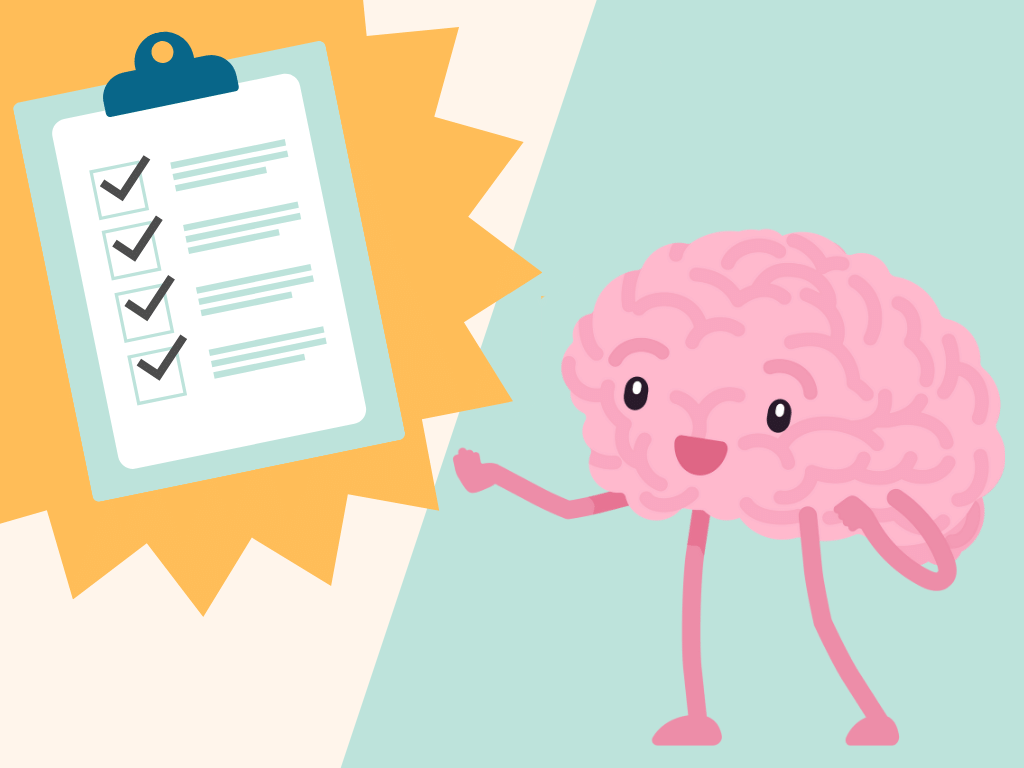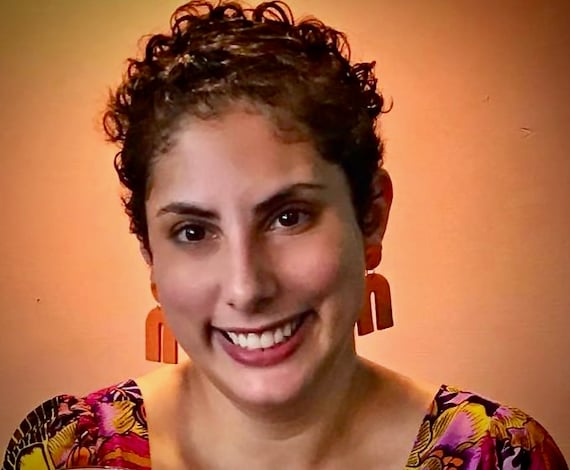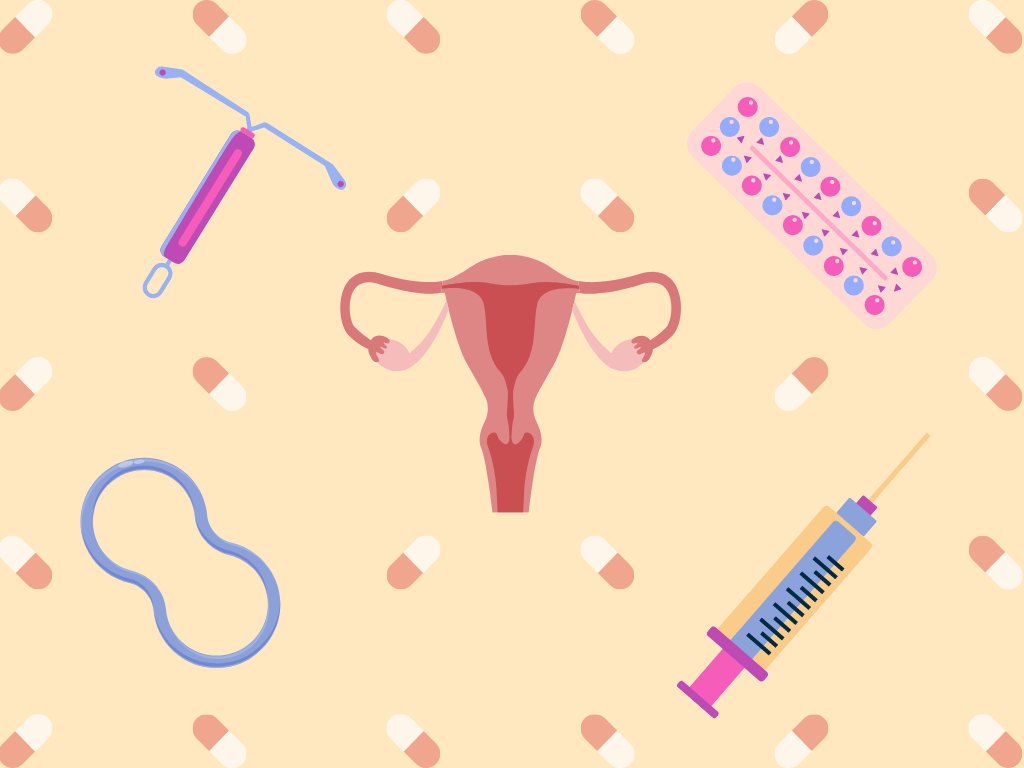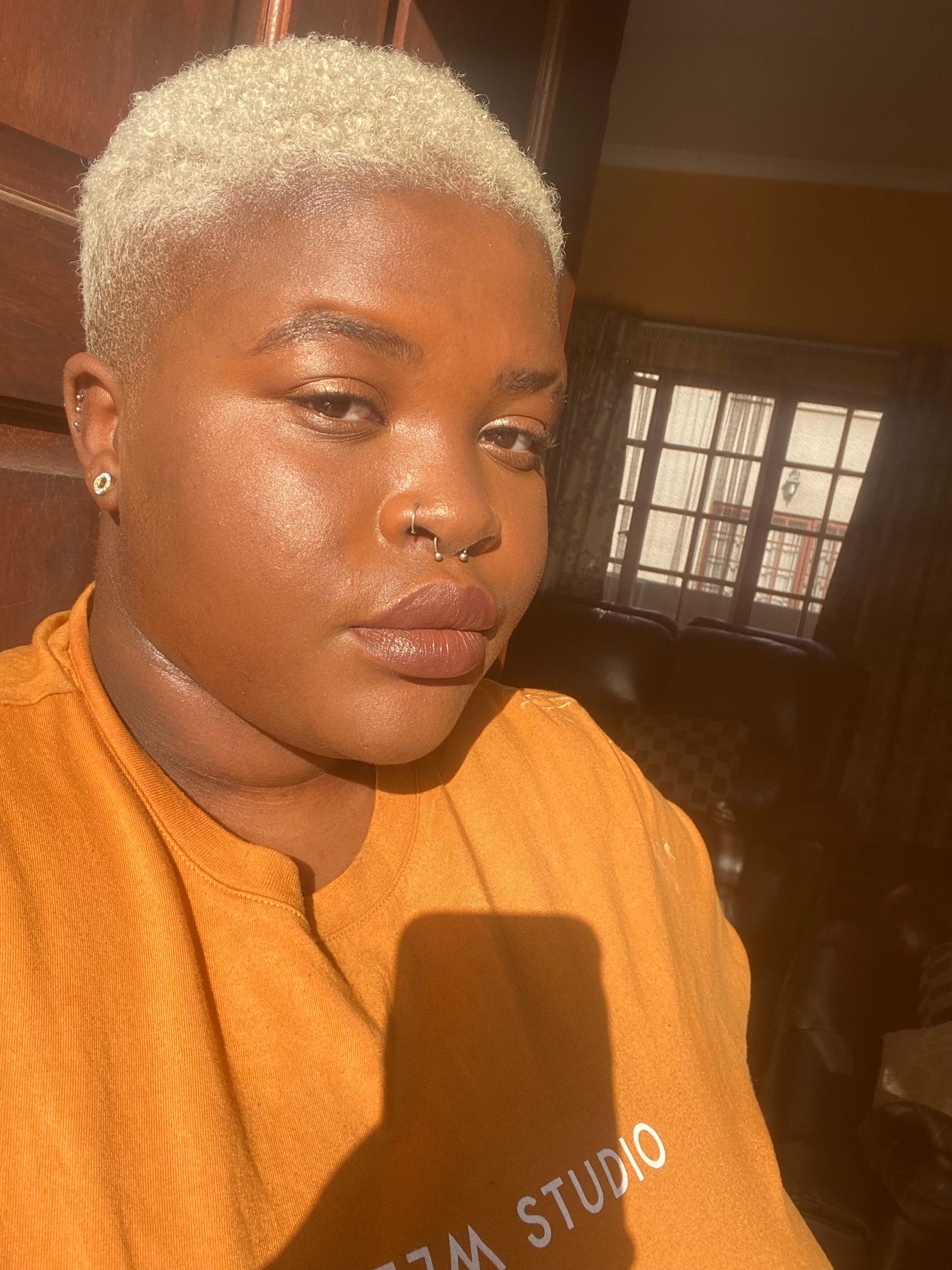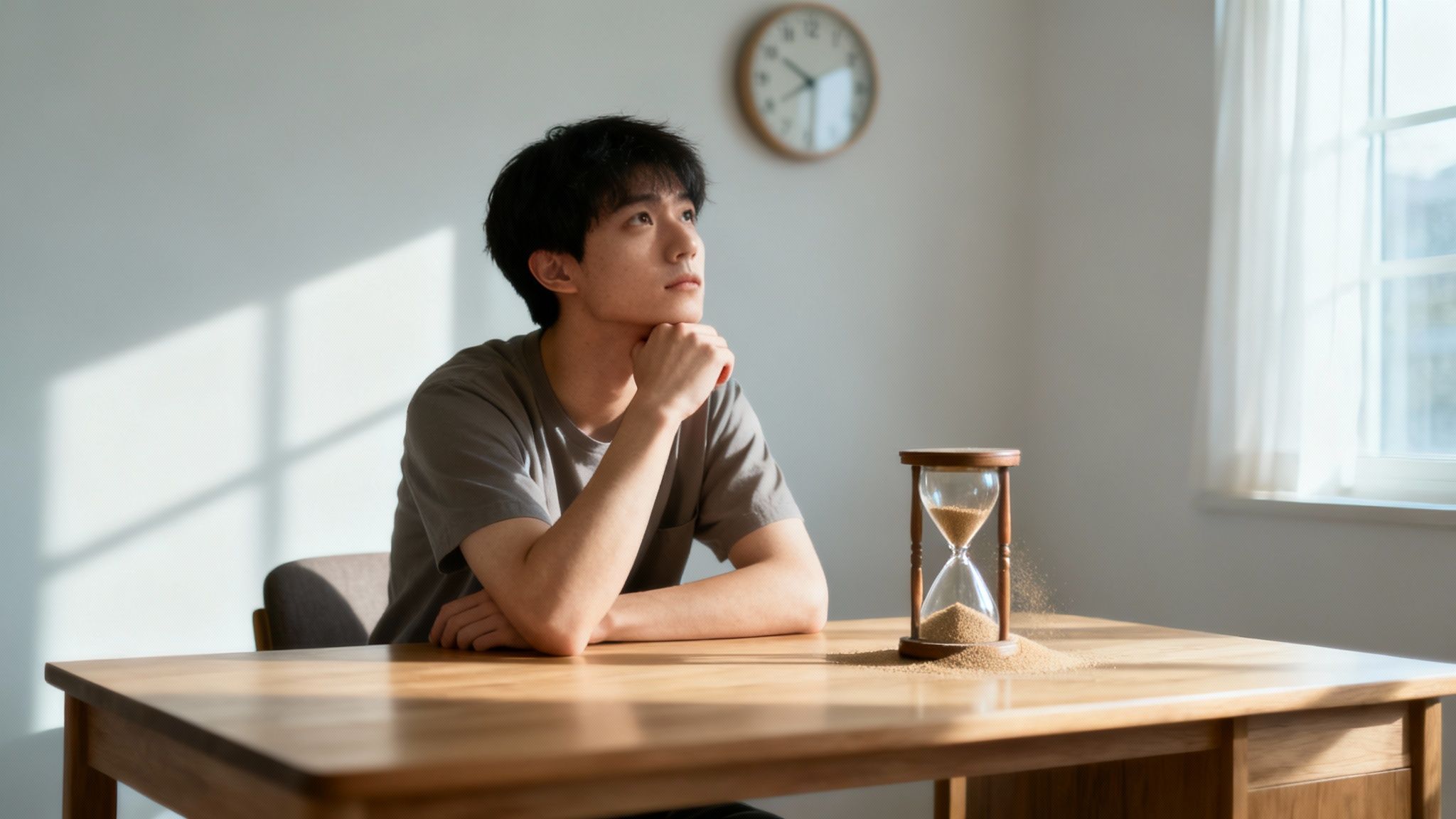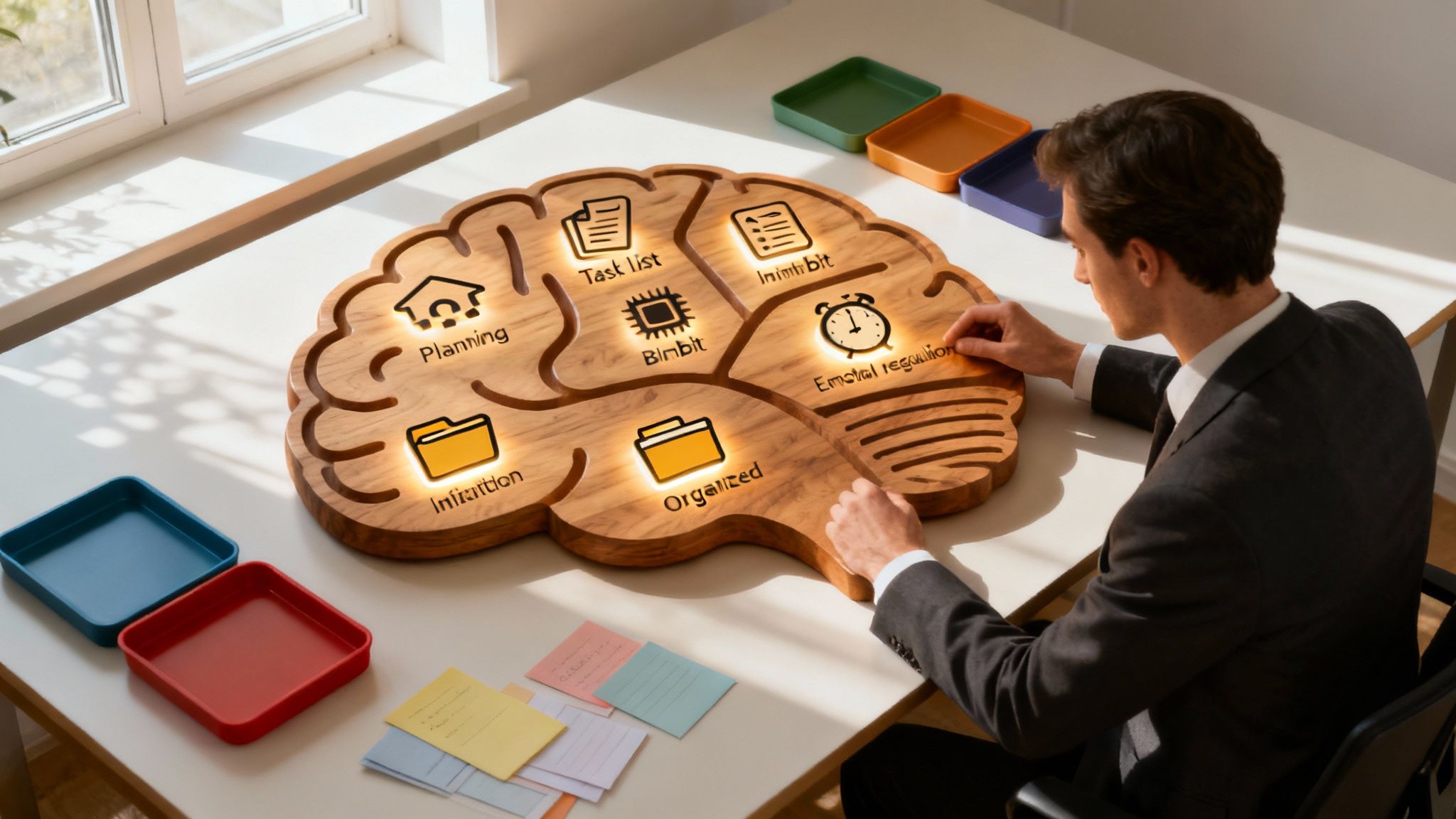If you’ve ever felt like your daily struggles just don’t fit the classic picture of ADHD—the hyperactive boy who can't sit still—you are so far from alone. For decades, that stereotype has dominated the conversation, leaving millions of women to navigate their symptoms in silence, feeling like they were somehow failing at life.
The truth is, ADHD often shows up very differently in women. It’s frequently shaped by societal expectations to be organized, agreeable, and emotionally steady. So instead of bouncing off the walls, the experience is often an intense, internal one.
You might recognize yourself in this feeling: looking in a mirror but not quite understanding the source of your challenges. It’s a common experience for women before an ADHD diagnosis finally helps the pieces click into place.
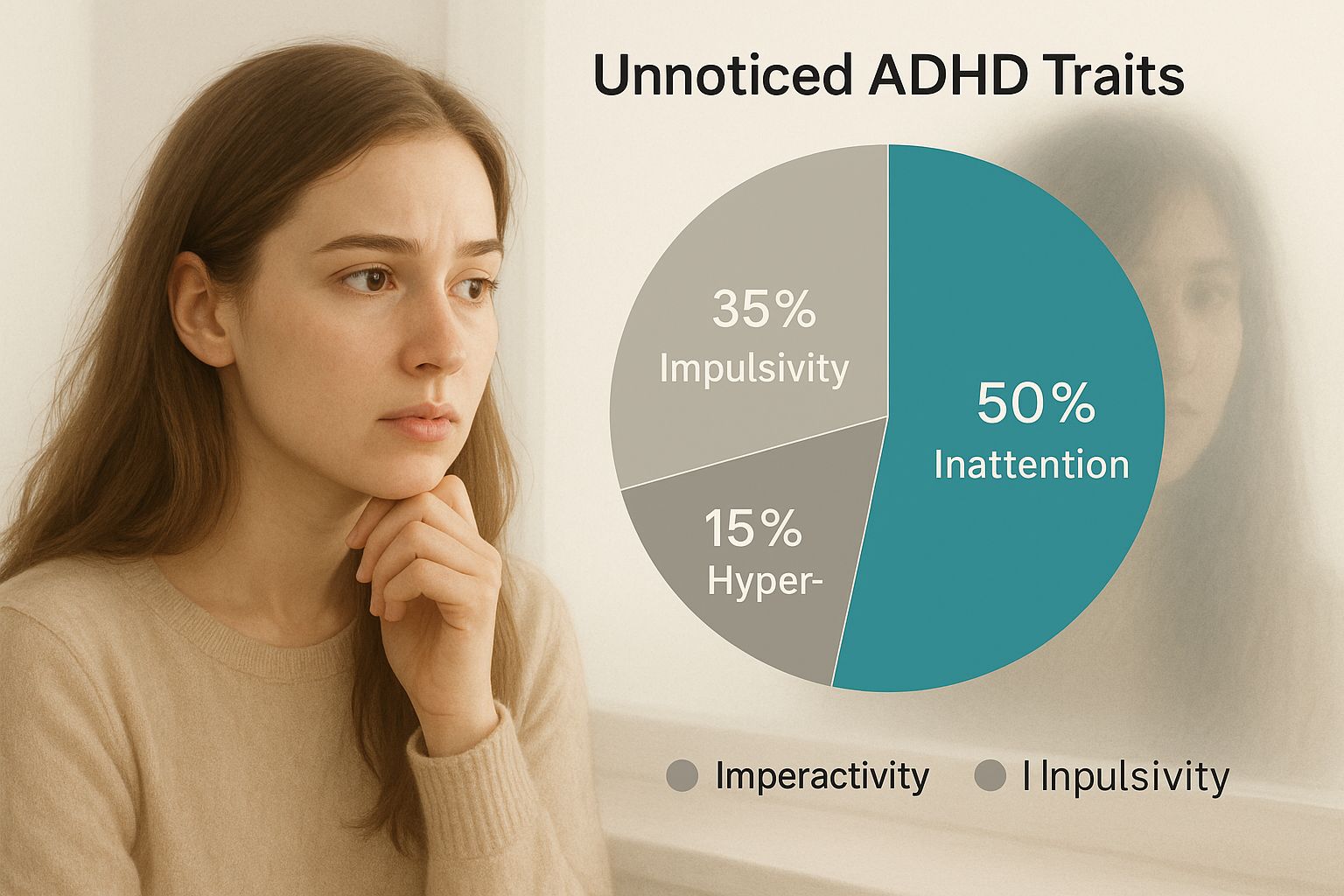
The Diagnostic Gap: Why Women Are Overlooked
Historically, ADHD has been massively underdiagnosed in women. The numbers tell a pretty stark story: while boys are diagnosed at a ratio of up to 4:1 compared to girls in childhood, that ratio closes to nearly 1:1 in adulthood.
💡 What does this mean? It suggests that countless women struggle for years—sometimes decades—before their ADHD is finally recognized, often after being treated for other things like anxiety or depression.
🔬 Scientific takeaway: This shift doesn't mean more women suddenly develop ADHD as adults. It means they were there all along, their symptoms misinterpreted or masked so effectively that they went unnoticed by parents, teachers, and even clinicians.
Internalized Symptoms vs. External Behaviors
The core difference often comes down to how symptoms are expressed. A boy might be visibly disruptive in class, but a girl with ADHD might be quietly daydreaming, her inattention easily mistaken for shyness or a lack of interest.
Instead of obvious hyperactivity, you might recognize these kinds of patterns in yourself:
- Emotional Overwhelm: Feeling emotions at full volume, leading to intense frustration over small setbacks or sudden, deep sadness.
- Chronic Self-Doubt: A nagging feeling of not being good enough, no matter what you achieve. This is often called imposter syndrome.
- Exhausting Perfectionism: Working twice as hard just to keep up appearances, creating meticulous systems to avoid feeling out of control.
Have you noticed this pattern in your own life?
Classic vs. Female-Presenting ADHD Symptoms
To really see the difference, it helps to compare the stereotypical symptoms with how they more commonly show up in women. One is external and obvious; the other is internal and much easier to miss.
This contrast highlights why so many women fly under the radar. Their struggles are real, but they look so different from what we've been taught to expect from ADHD.
These misunderstood and misdiagnosed patterns are incredibly common. Recognizing that you aren't 'broken'—but that your brain is simply wired differently—is the first, most powerful step toward understanding yourself.
The Reality of Inattentive ADHD
When most people hear "ADHD," they picture the stereotype: a little boy, bouncing off the walls, full of disruptive energy. But for a huge number of women, the experience is the complete opposite. It’s an internal, often silent struggle defined by inattentive ADHD, the most common presentation in women.
This isn’t about being "lazy" or "careless." Inattention is a brain-based challenge with executive functions. Imagine you're trying to tune into one radio station, but there are ten others blaring static at full volume. That’s what living with inattentive symptoms can feel like—a constant mental noise that makes it incredibly hard to focus, organize your thoughts, and see tasks through to the end.
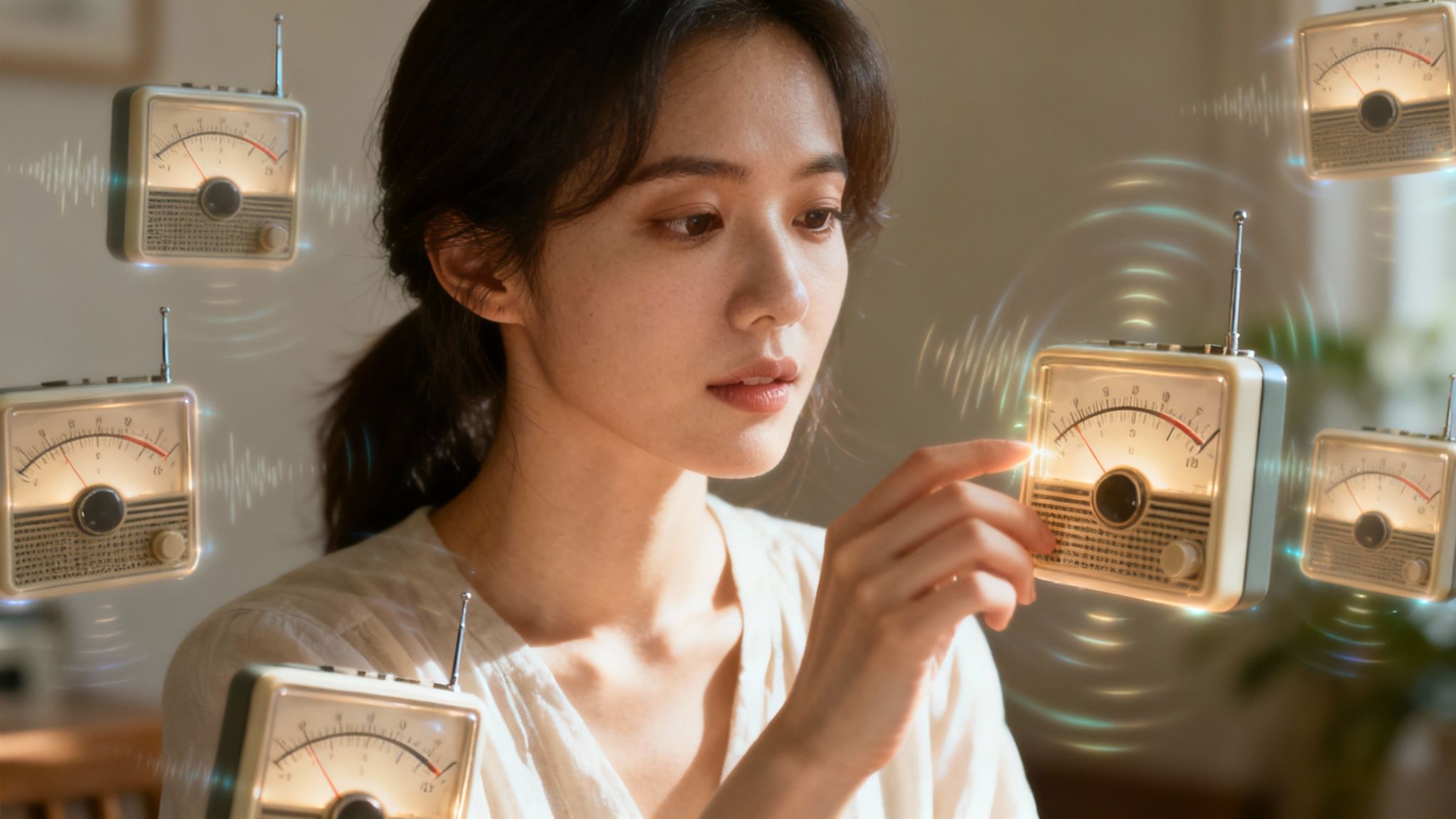
This ongoing battle often leads to intense frustration and a whole lot of self-blame. You might find yourself wondering why simple, mundane tasks feel like climbing a mountain, or why you can’t just "try harder" to pay attention like everyone else seems to.
What Inattention Really Looks Like
Inattentive ADHD is so much more than just daydreaming. It’s a persistent pattern that pops up in all different areas of your life, often in ways that are easily mistaken for personality flaws. The mental effort it takes just to push through this "brain fog" is immense and can be completely exhausting.
💡 Here's a key insight: It's a profound sense of being perpetually overwhelmed, even when your external life looks calm. You might feel like you're constantly running on a treadmill, working twice as hard just to stay in the same place.
This internal state shows up in tangible, everyday challenges. Recognizing these patterns is the first step toward understanding that you're not failing—your brain is simply navigating a different set of obstacles. The Inflow app provides tools and programs designed to help manage these exact challenges, turning that overwhelming feeling into actionable steps.
Common Inattentive Symptoms Checklist
Do any of these experiences hit a little too close to home? Many women with ADHD see themselves in these common patterns. This isn't a diagnostic tool, of course, but seeing these behaviors laid out can be a powerful, validating moment.
✅ Struggling to follow conversations: You find your mind wandering during meetings or chats with friends. You often miss key details and have to ask people to repeat themselves, hoping they don't think you weren't listening on purpose.
✅ Frequently misplacing essential items: Keys, your phone, your wallet—they seem to have a life of their own, vanishing into thin air and causing daily stress and frustration.
✅ Difficulty completing mundane tasks: You can hyperfocus on a new passion project for hours, but it feels almost physically painful to finish the laundry, pay bills, or answer emails.
✅ Making "careless" mistakes: No matter how hard you try, you overlook details at work or at home. This leads to errors that can make you feel incompetent, even when you know you're not.
✅ Appearing forgetful or absent-minded: You might miss appointments or forget important dates, not because you don't care, but because your brain struggles with organization and recall.
✅ Feeling mentally "foggy" or sluggish: It often feels like your brain is wading through mud, making it hard to think clearly or make what should be simple decisions.
These patterns are not moral failings; they are classic signs of how inattention shows up in real life. Does seeing them written out bring any clarity?
Understanding Emotional Intensity and Rejection Sensitivity
When we talk about ADHD in women, we can't just talk about focus and organization. So much of the experience is tangled up in our emotions. If you’ve ever felt like your feelings are just bigger or more intense than everyone else’s, you’re not alone. It’s not a character flaw—it’s a core, yet often overlooked, part of how ADHD shows up.
This is often called emotional dysregulation. Imagine a stereo system where the volume knob is permanently stuck on high. A minor frustration can feel like a catastrophe. A moment of happiness can be pure ecstasy. And a letdown? It can feel absolutely soul-crushing.
Bouncing back from these emotional highs and lows can take way longer, too, leaving you feeling exhausted and just… done. It's no wonder this emotional intensity is so often mistaken for a mood disorder.
The Pain of Rejection Sensitivity
One of the sharpest edges of this emotional intensity is something called Rejection Sensitive Dysphoria (RSD). While it’s not an official diagnosis you'll find in the DSM-5, the term resonates deeply with so many in the ADHD community, especially women.
RSD is an extreme, painful sensitivity to the perception of being rejected, teased, or criticized. Notice the word "perception"—it doesn't even have to be real. It feels like a sudden, physical wound, and the pain is immediate and overwhelming.
This intense fear of rejection often leads to developing some pretty exhausting coping strategies:
- People-Pleasing: You bend over backward to make everyone happy, often pushing your own needs aside, just to dodge any chance of disapproval.
- Social Avoidance: You start ducking out of social events, passing on new opportunities, or keeping your opinions to yourself—all to avoid potential judgment.
- Perfectionism: You work tirelessly to make everything flawless, operating under the belief that if you're perfect, no one can possibly find fault with you.
💡 Here's the takeaway: Trying to manage these intense emotional reactions is draining. It’s like you’re walking an emotional tightrope every single day, just trying to stay balanced while your brain’s emotional wiring works against you. This isn’t a personal failure; it’s a real, neurobiological part of the ADHD experience.
Living on this emotional rollercoaster can feel incredibly isolating, but just understanding why it's happening is a massive first step. To dig deeper into this, check out our guide on the signs of Rejection Sensitive Dysphoria. Learning to spot these patterns is the key to finding strategies that actually help.
The Hidden Work of Masking and Perfectionism
If you’ve spent your life feeling like you're "just barely holding it together" despite looking successful on the outside, you might be an expert at something you didn't even realize you were doing: masking. This is one of the most significant—and most overlooked—ADHD symptoms in women.
Masking is the often unconscious process of hiding your struggles to fit in and meet everyone else's expectations. It’s the immense, invisible effort you pour in every single day to appear organized, calm, and totally on top of things, even when your internal world feels like pure chaos. It's a survival strategy, plain and simple. But it comes at a very high cost.

This constant performance is mentally and emotionally draining. Unsurprisingly, it often leads to severe burnout, anxiety, and that persistent, nagging feeling of being an imposter.
What Masking Looks Like in Real Life
Masking isn't just about "faking it." It’s about developing complex, often exhausting, coping mechanisms that hide the real challenges of ADHD. These behaviors can become so ingrained that you might mistake them for your actual personality.
Sound familiar? You might recognize yourself in these patterns:
- Obsessive Organization: You create rigid systems—insanely detailed to-do lists, complex planners, or hyper-organized spaces—not because you're naturally tidy, but out of a deep-seated fear of falling apart if you don't.
- Relentless Perfectionism: You hold yourself to impossibly high standards, believing that if your work is flawless, no one will ever notice how much you struggled to get it done. This is a classic recipe for procrastination, as tasks feel too huge and daunting to even start.
- Being Overly Agreeable: You might become a chronic people-pleaser, saying "yes" to every request and avoiding conflict like the plague. This is often a way to head off potential criticism or rejection, which can feel intensely painful for the ADHD brain.
💡 The core idea: The goal of masking is to project an image of effortless competence. But behind the scenes, you’re working twice as hard as everyone else just to stay afloat. It can make you feel deeply, profoundly alone and misunderstood.
The True Cost of Hiding
Living behind a mask is completely unsustainable. The constant mental energy it takes to suppress your natural tendencies and monitor your every action is a direct flight to exhaustion. Many women who mask their ADHD symptoms eventually hit a wall, leading to a frustrating cycle of burnout and recovery.
And this is more than just feeling tired; it’s a state of profound emotional and physical depletion. The constant pressure to be perfect while feeling like a fraud on the inside can also fuel anxiety disorders and depression.
Recognizing these patterns is the first, crucial step toward breaking free. It’s about learning to work with your brain, not against it. Unpacking the connection between ADHD masking and burnout can be an incredibly validating experience on your journey to self-acceptance.
Learning to unmask is a process of self-compassion, and it's something you don't have to do alone. Tools like the Inflow app are designed to help you build sustainable habits that honor your brain's unique wiring, so you can thrive without the exhausting performance.
Your Path to Diagnosis and Self-Understanding
Realizing you see yourself in the patterns of inattentiveness, emotional intensity, or masking is a massive first step. It's often an emotional one, too. The next step is getting clarity. This isn't just about sticking a label on things; it's about finding a framework that helps you understand yourself, reframe a lifetime of struggles, and finally move forward with more self-compassion.
Thinking about a formal diagnosis can feel huge and overwhelming, but it’s really an act of taking back control. It's the key that unlocks the right kinds of support and strategies for your unique brain.
Finding the Right Professional
When you start looking for an ADHD evaluation, it’s so important to find a clinician who really "gets it." Not every doctor or therapist is trained to see the subtle, internalized ways ADHD shows up in adult women. You’re not just looking for someone with a medical degree; you need a partner for this journey.
Here are a few things to keep an eye out for:
- Specialization in Adult ADHD: Look for psychologists, psychiatrists, or neurologists who specifically mention adult ADHD and ADHD in women as part of their expertise.
- A Holistic Approach: A good clinician will go way beyond a simple checklist. They’ll want to hear about your entire life—your childhood, your career, your relationships, and how these symptoms actually impact you day-to-day.
- Validating Language: When you have that first chat, pay attention to how they respond to your struggles. Do you feel seen and heard? Or do you feel dismissed and judged? Trust your gut on this one.
What to Expect During an Evaluation
An ADHD evaluation is much more than a quick conversation. It’s a deep dive meant to get a full picture of your brain's patterns. The exact process can differ, but it usually involves a detailed clinical interview, filling out some rating scales, and sometimes cognitive testing to make sure nothing else is going on.
💡 A diagnosis isn't the finish line; it’s the starting line. It provides the "why" behind your struggles, allowing you to finally stop blaming yourself and start building strategies that work with your brain, not against it.
This shift in perspective is everything. Because symptoms in girls are so often about inattentiveness rather than obvious hyperactivity, countless girls fly under the radar until they're adults, which helps explain why so many women are undertreated. You can dig deeper into these ADHD statistics and their implications on the CDC's website.
It can be a huge help to prepare for your evaluation by tracking your symptoms beforehand. Using a tool like the Inflow app can help you notice and write down specific patterns, giving you concrete examples to bring to your clinician. If you're ready to see whether your own experiences line up with ADHD, taking the Inflow quiz is a great, low-pressure place to start.
Thriving With Your ADHD Brain
Receiving a diagnosis isn't the finish line; it’s really more of a starting block. This is the beginning of a whole new chapter—one where you can finally stop blaming yourself and start working with your brain’s unique wiring, not against it. The goal isn't to "fix" your ADHD. It's to learn how to flourish with it.
It's a big shift in perspective. Instead of fighting your brain every single day, you start supporting it. It’s all about building a life that actually fits your natural wiring, rather than trying to cram yourself into neurotypical boxes that were never designed for you in the first place. This new way forward is built on self-awareness, kindness, and having the right tools in your corner.
Building an ADHD-Friendly Life
Thriving with ADHD often starts with small, practical changes that make your day-to-day life a little smoother. Forget perfection. We're aiming for what's actually sustainable for you.
- Create ADHD-Friendly Routines: Rigid, minute-by-minute schedules? Probably not going to happen. Think more in terms of flexible "rhythms" to guide your day. For instance, you could try linking your morning coffee to emptying the dishwasher—creating a simple, repeatable habit without a ton of pressure.
- Lean Into Your Strengths: Your ADHD brain has some serious superpowers. You can channel that intense hyperfocus into projects you're genuinely excited about. Or you can embrace your creative, out-of-the-box thinking to solve problems in a way no one else would. These aren't just weird quirks; they're legitimate assets.
- Practice Self-Compassion: For every single time you misplace your keys or blank on an appointment, try to offer yourself the same kindness you’d give a friend in the same boat. Your brain is working overtime. Piling on self-criticism just adds to the mental load.
💡 Here's the powerful truth: Understanding your ADHD is a huge first step, but turning that knowledge into action is where things really start to change. It’s about building skills and strategies that make life feel less like a constant uphill battle.
This is exactly where a structured, supportive space like the Inflow app can be a game-changer. With skill-building modules designed specifically for executive function challenges, community support from other people with ADHD who just get it, and expert coaching, Inflow gives you the framework to actually put these strategies into practice.
With the right mindset and support, you can move way beyond just managing symptoms and start to truly thrive. Ready to build your toolkit? Take the Inflow quiz to kickstart your journey of self-discovery and empowerment today.
Answering Your Questions About ADHD in Women
Stepping into the world of ADHD can feel like finally finding a word for an experience you've had your whole life. It's natural for a lot of questions to pop up, especially when the classic stereotypes don't fit. Let's walk through some of the big ones together.
FAQ on ADHD Symptoms in Women
Here are some quick answers to the questions we hear most often from women exploring a potential ADHD diagnosis.
Hopefully, seeing these questions and answers helps you feel a little less alone and a lot more understood.
Feeling seen is one thing, but turning that recognition into real change is the next move. The Inflow app is designed to help you do just that, with science-backed programs to manage your symptoms and build a life that actually works with your brain.



